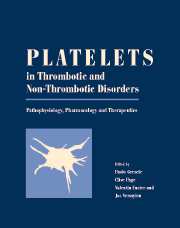Book contents
- Frontmatter
- Contents
- List of contributors
- Editors' preface
- PART I PHYSIOLOGY
- PART II METHODOLOGY
- 30 In vitro assays for evaluating platelet function
- 31 Monitoring antiplatelet therapy
- 32 Flow cytometric analysis of platelet function
- 33 Animal models of platelet-dependent thrombosis
- PART III PATHOLOGY
- PART IV PHARMOLOGY
- PART V THERAPY
- Afterword: Platelets: a personal story
- Index
- Plate section
33 - Animal models of platelet-dependent thrombosis
from PART II - METHODOLOGY
Published online by Cambridge University Press: 10 May 2010
- Frontmatter
- Contents
- List of contributors
- Editors' preface
- PART I PHYSIOLOGY
- PART II METHODOLOGY
- 30 In vitro assays for evaluating platelet function
- 31 Monitoring antiplatelet therapy
- 32 Flow cytometric analysis of platelet function
- 33 Animal models of platelet-dependent thrombosis
- PART III PATHOLOGY
- PART IV PHARMOLOGY
- PART V THERAPY
- Afterword: Platelets: a personal story
- Index
- Plate section
Summary
Introduction
Acute thrombotic occlusion of an atherosclerotic coronary or cerebral artery, leading to myocardial infarction or stroke, respectively, is still the leading cause of mortality in the Western world. Furthermore, acute thrombotic complications seriously compromise modern interventional approaches to the management of atherosclerotic vascular disease. Therefore, the development of effective antithrombotic therapies for acute arterial thrombotic occlusion still represents an important public health strategy.
Our understanding of the basic molecular processes involved in the formation and dissolution of thrombus has expanded rapidly in recent years, and this basic research has led to the generation of novel, potent, and clinically relevant antithrombotic agents, such as tissue plasminogen activator and its mutant forms, ticlopidine and clopidogrel, and Gp IIb/IIIa inhibitors. These agents are currently part of the clinical armamentarium available to the clinical cardiologist for the treatment of thrombotic disorders. With no doubts, therefore, the evaluation of these – as well as newer and perhaps even more effective – molecules requires relevant quantitative animal models of acute thrombosis; the ultimate application of new antithrombotic pharmacological agents being developed through the use of modern technology depends on the appropriate assessment in vivo to ensure their efficacy and safety.
Thus far, however, it has not been possible to reproduce, in an experimental model, the most common clinical cause of arterial thrombosis – an ulcerated or fissurated atherosclerotic plaque. Although during the past few years many animal models have been developed, the ideal model is far from being available, and this limitation should always be kept in mind.
- Type
- Chapter
- Information
- Platelets in Thrombotic and Non-Thrombotic DisordersPathophysiology, Pharmacology and Therapeutics, pp. 499 - 512Publisher: Cambridge University PressPrint publication year: 2002



